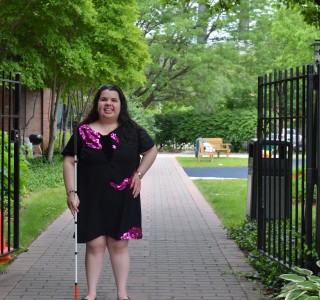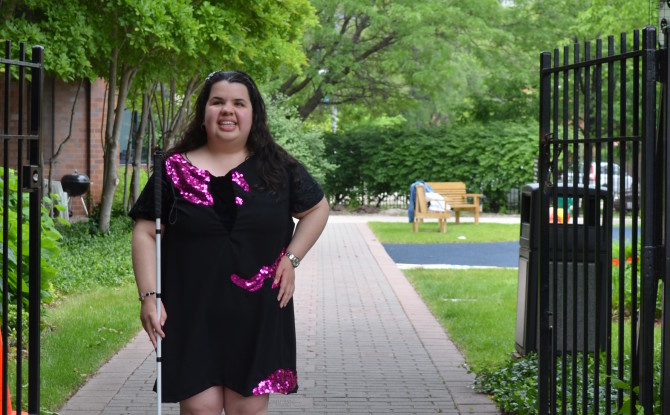
Clothing Design for the Blind and Visually Impaired: Is It Any Different?
Oct. 1, 2015
Last week I wrote a commentary about how people with disabilities are being included in fashion events. A question I sometimes get is what kind of clothing do blind and visually impaired individuals prefer or need? Truth is though, that like everyone else we have different styles and preferences. This is something that a group of students and their professor from the School of the Art Institute of Chicago (SAIC) recently discovered after forming a partnership with several Lighthouse staff and program participants, myself included. Each student was assigned a partner for the entire project, and had to create a garment tailored to the person’s individual wants and needs.
Cheryl Pope is a professor of fashion and design at SAIC, and one of the organizers of this project. She had previously heard about The Chicago Lighthouse and wanted to get involved for a long time. Since she always tries to engage her students with the community, Cheryl realized that this would be the perfect opportunity.
The clothing designed was as diverse as each participant. Garments ranged from baseball caps to elegant dresses. Whether it was a special texture or color the user wanted to incorporate into the garment, each student carefully worked one-on-one with his or her partner to make sure the clothing had a perfect fit and personal touch.
Amanda Yamasaki worked with Daniela Estrada, a Lighthouse employee and law student at the University of Illinois at Chicago. Since Daniela is pursuing a career as a lawyer, she wanted a dress that would both look professional and feel comfortable. She also wanted something that would be easy to fasten – as women we have all experienced the difficulty of zipping up those back zippers on dresses! Amanda made a dress with buttons on the shoulders. She says that this experience helped her become more aware about how clothing feels on the body as well as some of the difficulties people might encounter with fastening accessories.
Other garments reflected the wearer’s interests. Miles Clark worked with Peter Tucic, an assistive technology expert. Peter wanted a simple but “high tech” t-shirt with a Quick Response (QR) code attached. Given that this was a simple design, Miles ended up making three of these shirts. Since both are into music, they decided to include different songs in each QR code. That way, Peter could identify each shirt by scanning the QR code and listening to the song with his Smartphone. Miles says that this experience not only taught him about design, but also gave him the unique experience of getting to work with and know a successful blind individual.
“I’m super grateful to be afforded this opportunity to work with this organization,” he said.
I too had the unique opportunity of working with this group of budding designers. Luis Mejico was my partner, and by the end of our brainstorming session we settled on a dress that would have both visual and tactile elements. Using his creativity along with my suggestions and preferences, Luis made a black dress with pink sequins and velvet sleeves – talk about a tactile and elegant dress! This was Luis’s first time designing a garment, and he says he learned a great deal from this experience. The fact that he made a custom designed garment and subsequently gave it to me was the most rewarding part for him.
I also enjoyed working with Luis and the entire group. This project gave me a better appreciation of what it takes to design and make clothing. Most of all, I learned that designers should get to know the wearers of their final products so they can meet their needs and preferences. I believe that if more designers work closely with people with disabilities, they will be able to better include this community in the fashion industry.
Professor Cheryl Pope and all of the students feel that the most important lesson they learned from this project is that people with disabilities are more alike than different when it comes to fashion and design.
”There are still so many crossovers, I think it’s not as dramatically different as some people may think,” Pope said. Still, getting to visit the Lighthouse and interacting with the staff and participants gave her more apathy toward the needs of people with disabilities. It also allowed her to think more about how to better include this population in the fashion and design industries.
Kudos to Professor Pope, Luis and all of the students for their effort and dedication to this project! In the end we all learned from this once in a lifetime opportunity, and I’m sure that it is something we will never forget. To the students: I definitely see a lot of potential in your future careers as designers. I sincerely hope you will continue working with people with disabilities so that we will be more integrated in the fashion and design industries in the near future. Thanks for your time and gifts, and we at The Chicago Lighthouse look forward to future partnerships with the SAIC students and staff!






